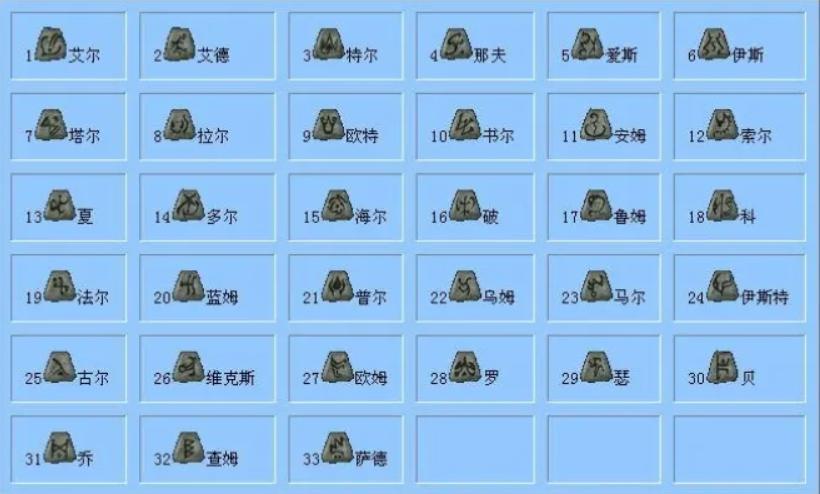Diablo 2, a game released by Blizzard in 2000, was once popular all over the world. The "dark" arpg style he pioneered has also become the target of imitation by many games.

Now that the game has spanned 22 years, its charm and popularity remain undiminished. Blizzard also released a remake in 2021, which made many players chant "Ye Qing is back", and also caused many players who had not experienced this masterpiece to choose to join the game.
However, because Diablo 2 is an old game, it does not do a good job in guiding newcomers. Many new players feel headaches when faced with various professional terms, strange information, and "encrypted" chats by veteran players. Next, I will briefly introduce one of the most important systems in Diablo 2: Runeword equipment. This introduction is completely for beginners, so that newcomers can understand it, so the content involved will not be too deep, and it is not suitable for players with certain gaming experience.
The main story begins below!
When it comes to the Rune Language system, we must first know what runes are. I believe that many players may have picked up a golden name during the game, perhaps by kicking open a jar on the side of the road, perhaps by killing a BOSS, or perhaps by beating a mob to death. runes, and these runes have their own names, such as "El", "Ed", "Ter", etc. Their functions are the same as the daily dropped gems, and the effects of embedding them into different equipment will be displayed above. . Because these names are so weird, we usually call the runes by numbers. For example, "El" is called the No. 1 rune in the table below, "Ed" is the No. 2 rune, and so on. Since such runes are not numbered in the game, if you want to know the number of the rune you picked up, you usually need to consult the table below, or use some mods to determine its serial number.

So how do we build this type of equipment?
The answer is simple. In addition to the descriptive effects of runes, when they are embedded into equipment in a specific order , they will transform it into powerful rune language equipment .

3. What equipment can be transformed into Rune Language equipment?
2. Equipment needs to have specific grooves. To give a simple example, for example, to build a "spiritual shield", you need to embed 4 runes into the equipment, but the equipment you get only has 3 or 2 grooves, or even no grooves. It is a pity that this equipment cannot Directly create a mental shield . It should be noted that if the base equipment has too many grooves, it cannot be made into rune equipment . Let’s take the spiritual shield as an example. Your shield has 5 grooves, and to build a spiritual shield, you only need to inlay 4 runes. Then inlaying After completion, there will be an empty slot. In this case, it cannot be made into rune equipment.
4. What if I have a piece of base equipment but there are no grooves?
1. Use our powerful Horadric Cube to punch holes Put the equipment you want to drill holes into the block together with the specified materials and synthesize them to complete the hole drilling work. This method can not only punch holes in the substrate, but can also punch holes in equipment of other colors. The specific punching materials are as follows:
1 Ral(8#) 1 Amn(11#) 1 Perfect Purple Gem Poreless Weapon = Same type of holed weapon
1 Tal(7#) 1 Thul(10#) 1 perfect topaz non-porous clothes = same type of clothes with holes
1 Tal (7#) 1 Amn (11#) 1 perfect ruby non-hole shield = the same type of shield with holes
1 Ral(8#) 1 Thul(10#) 1 perfect sapphire non-hole helmet = the same type of helmet with holes But here we need to note that punching holes in this way is random. Let’s take the shield just now as an example. If you get a ruler’s large shield without grooves, then when we use blocks to drill holes, you may make 4 holes, or you may make 3, 2, or 1 hole. .
2. Make holes with the help of tasks
The specific hole checking website is: https://ttbn.cn/data/sock.html It is important to note that if your equipment already has holes, no matter method 1 or method 2, you cannot drill holes again. For example, you obtain a 2-hole shield, and look up the table and find out that the maximum number of holes in the shield is 4. Unfortunately, neither method can change the number of holes in this piece of equipment, even for drilling tasks.
5. Is the same Rune Language equipment stronger or weaker?
The answer is yes. The strength of Rune Language equipment mainly depends on two points.
1. The strength of the substrate

Take weapon damage as an example, normal<expanded<elite. This will also cause the rune equipment we create to have different damage. Therefore, when building rune weapons, try to choose elite equipment.
2. Random attributes generated by runes
Still taking the mental shield above as an example, we can see that its casting speed is 33%. This value is not static. The maximum value is 35%. Every time a mental shield is built, this value fluctuates .
Something to note! Cleaning does not mean refreshing your attributes again, but it will erase all the runes that have been embedded and turn the equipment into a blank slate again. You need to insert the runes into it again.